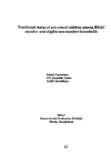Nutritional status of pre-school children among BRAC member and eligible non-member households
Citation
Tarannum, S., Ziauddin , S. M., & Chowdhury, A. (1997). Nutritional status of pre-school children among BRAC member and eligible non-member households . Research Reports (1997): Health Studies, Vol - XXII, 41–65.Abstract
The study aimed at describing determinants of nutritional status of the pre-school
children in BRAC member and eligible non-member households. The data were obtained
from 9~840 children aged less than S years from April 1994 through December 1996
. residing in 100 villages of 3 rural thanas (sub-districts) namely Saturia, Santhia and
Mirzapur. The findings showed that overall prevalence of stunting and wasting was 62%
and 18~·(, respectively. i Significantly lower proportion of female compared to male
children 9.-·c-e stunted (p<O.OOl). There was no significant sex difference in the
proportion of wasting. The prevalence of stunting was lower among children in BRAC
member compared to non-member eligible households (62% vs. 66%) (p<O.OS). The
prevalence of stunting and wasting was significantly associated with point prevalence of
diarrhoea and acute respiratory infection ( .... 1\R.I) (p<O.Ol). Prevalence of wasting was
significantly associated with vitamin A capsule coverage and place of defecation
(p<O.Ol). Children (45~o) who belonged to female headed households were less stunted
compared to male headed households (640fo). Prevalence of stunting was significantly
associated with family size and parent's literacy (p<O.Ol). In case of families, whose
main earners were non-labour, prevalence of stunting was lower compared to manual
labour households. Prevalence of stunting and wasting was significantly associated with
Seasonality (p<O.Ol). Prevalence of stunting and wasting was significantly higher among
non-member eligible households compare to BR.AC member households. It is necessary
to create awareness about nutrition all over the country, especially focused on rural
community. More emphasis should be given on nutrition, health and hygiene among rural
population for nutritional well-being

